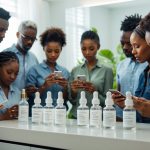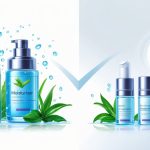Vitamin C Serums Finally Getting Results Doctors Stand Behind
So, vitamin C serum. I walk into Target and suddenly everyone’s an expert—like, do you even know what L-ascorbic acid is, or are you just parroting TikTok? I’ve lost count of how many times I’ve heard “doctors aren’t convinced” or “just eat an orange.” Honestly, I used to believe the same thing. But apparently, now dermatologists are actually recommending some of these serums—especially the ones with stabilized vitamin C—because, get this, they’re seeing real changes in skin brightness, texture, firmness, whatever. Is it the formulas? The studies? Or just better marketing? I’m still not totally convinced, but okay, sure, I’ll play along.
Standing in the aisle, I’m squinting at words like “THD ascorbate” and “niacinamide,” and honestly, I can’t remember a single thing Dr. Cheung said in that podcast. Something about “get it cold,” “keep it out of the sun,” “it oxidizes,” blah blah. My dermatologist friend swears the best proof comes from split-face trials—one side gets serum, the other doesn’t, and people actually notice smoother, brighter skin where they use the stuff. But then someone else blames “too many dogs at the park” for their results, so who even knows. Also, if Olay and Sunday Riley keep popping up in legit reviews, maybe there’s something to it? Or maybe we’re all just suckers for pretty bottles.
What Even Makes a Vitamin C Serum Work?
Try telling your mom vitamin C isn’t just a scam. Two years ago, I’d have laughed in your face. But if you dig through PubMed (or just Google, let’s be real), there are these studies—double-blind, actual science—showing L-ascorbic acid can reduce fine lines and sun damage. It’s a strong antioxidant, but if the formula’s unstable, it’s basically useless. Like, the fancy dropper bottle isn’t just for aesthetics. If it’s clear and sitting in sunlight, congrats, you just paid $60 for orange water.
So, What Does Vitamin C Actually Do?
Here’s the weird part: my skin shrugs at oranges, but the second I slap on a 15% L-ascorbic acid serum—instant tingle. Apparently, that means it’s working? L-ascorbic acid boosts collagen production. That’s not just marketing, that’s actual biochemistry. Dr. Mona Gohara says, “Vitamin C modulates pro-collagen mRNA expression.” I mean, sure, if you say so.
But it’s not just about brightening. Vitamin C blocks melanin production (tyrosinase inhibition, if you care), so it’s supposed to fade dark spots—unless you mess up the pH or use a formula that’s gone bad. Water-based, low pH, 10–20%—that’s the sweet spot, but go higher and my face turns into a tomato.
Antioxidant Hype: Is It Real or Nah?
Here’s what nobody tells you: free radicals aren’t just a buzzword. They’re real, and they’re mostly from sun and pollution. L-ascorbic acid literally sacrifices electrons to neutralize these little troublemakers. Not even poetic, just chemistry. You want the serum to get into your skin—not just sit there and smell like citrus. Vitamin E and ferulic acid make vitamin C work even better (hello, SkinCeuticals C E Ferulic—15% C, 1% E, 0.5% ferulic, and a price tag that hurts). Studies back it up. But if you leave your serum on the windowsill, all bets are off. Brown goo, wasted money, no results. And nobody ever talks about how fast vitamin C breaks down—seriously, why is that?
L-Ascorbic Acid, THD Ascorbate, and the Ingredient Jumble
Reading ingredient lists is like decoding a chemistry quiz: L-ascorbic acid, THD ascorbate, magnesium ascorbyl phosphate (MAP), sodium ascorbyl phosphate (SAP)—what’s the difference? L-ascorbic acid is the gold standard, but only if it’s stabilized and at the right concentration. THD ascorbate is oil-soluble, so it’s supposed to go deeper, but there’s way less research. MAP and SAP are gentler, so K-beauty brands love them, but I honestly have no clue if anything under 8% does a thing. If I can’t find a study, I don’t trust it—end of story.
Supposed “Doctor-Backed” Benefits: Any Truth Here?
Let’s be real: no dermatologist is promising you’ll look like a Facetune filter overnight. I can sniff out a $150 serum by the smell alone, but if the ingredients are trash, it’s still trash. Clinical proof matters, but so does not expecting a miracle after three uses. Dark spots and fine lines? Yeah, you’ll see something—eventually. Maybe.
Brightening: Can You Really “Glow”?
I still see my own acne scars in every mirror, even after a year of serums. But I did notice my skin looked less dead after I actually committed to a 15% L-ascorbic acid serum for three months straight. That’s what the NIH says, too—vitamin C fights free radicals and stops your skin from looking like it belongs in a zombie movie. My friend texted me that she “looked healthy for the first time in years” after using Timeless 20% C + E Ferulic for three weeks. She’s the ninth person I know who swears by that one. Dr. Lal says it’s the concentration that matters, not the price. Oh, and sunscreen in the morning is non-negotiable, or you’re just wasting time.
Fading Spots: Slow and Painful
Hyperpigmentation is the bane of my existence. I used to cake on concealer, but after a few months of vitamin C (10-20%, real forms only), the spots started to lighten. Dr. Pitman says, “Expect gradual but solid improvement.” Not instant, not dramatic. The combo of C, E, and ferulic acid works better than just C alone. I took progress pics, and the difference at week 12 was actually noticeable. Still, I have one stubborn spot that refuses to budge. Typical.
Collagen and Firmness: Don’t Hold Your Breath
Firmness is hard to measure unless you’re obsessed with your own jawline, which, okay, maybe I am. Dermatologists say vitamin C boosts collagen, so you get fewer fine lines and less sag—if the serum’s fresh. If it turns orange, toss it. I learned that the hard way. Collagen doesn’t come back overnight, but after a couple months, my face looked a little less deflated. Small victories, I guess.



